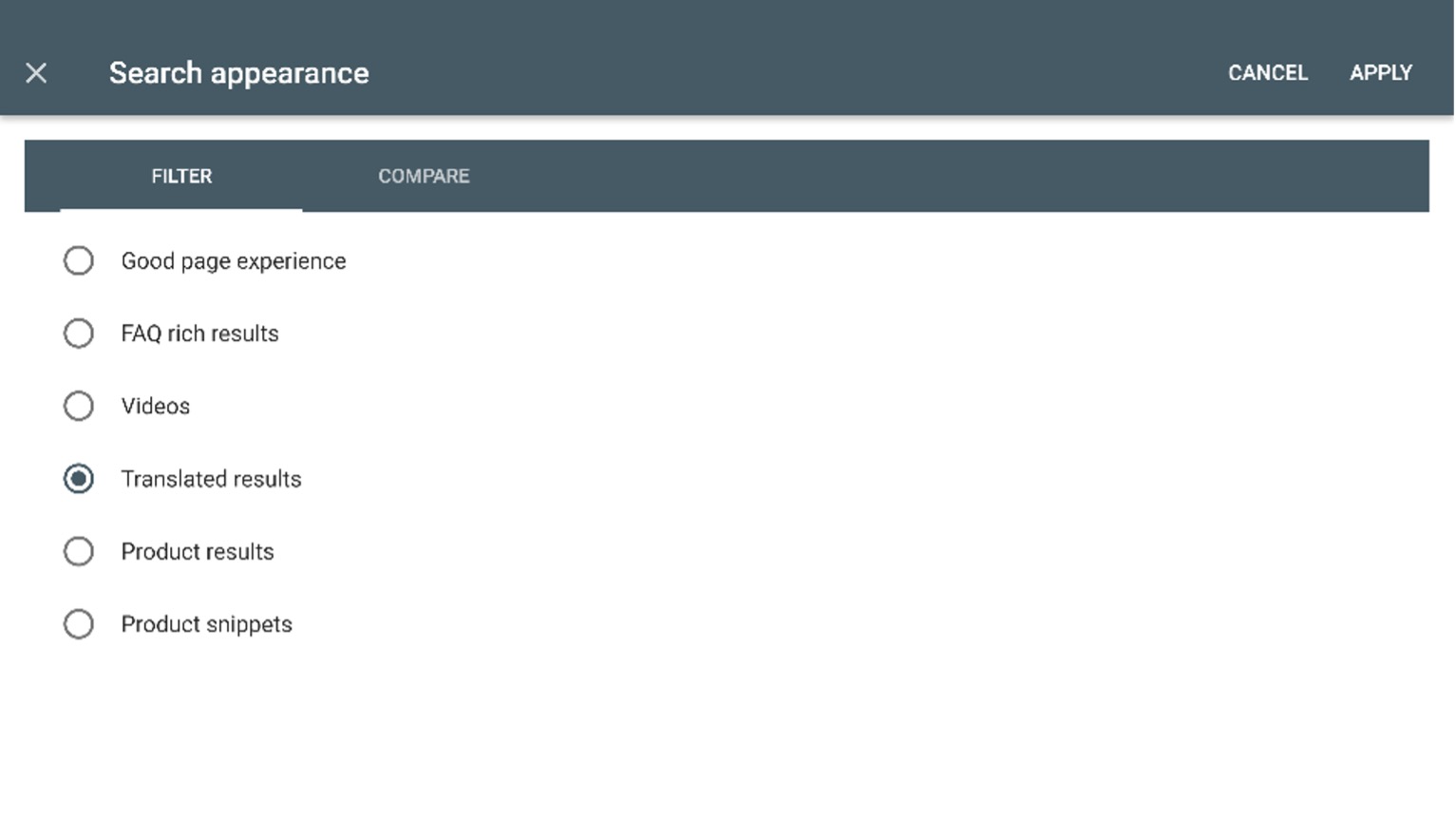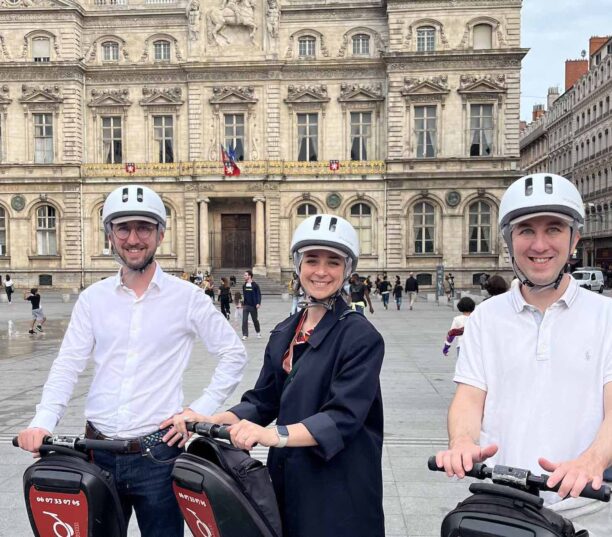Consulting the Google Search Status Dashboard on the morning of May 31st, we see that there were no updates to Google Search in May 2023. Volatility in search results, though, was important enough for us to imagine that there were in fact 4 updates that Google is not telling us about! And there is something even bigger coming down the line: the introduction of AI-generated responses and chat to Google Search unveiled during Google I/O and now available to test online.
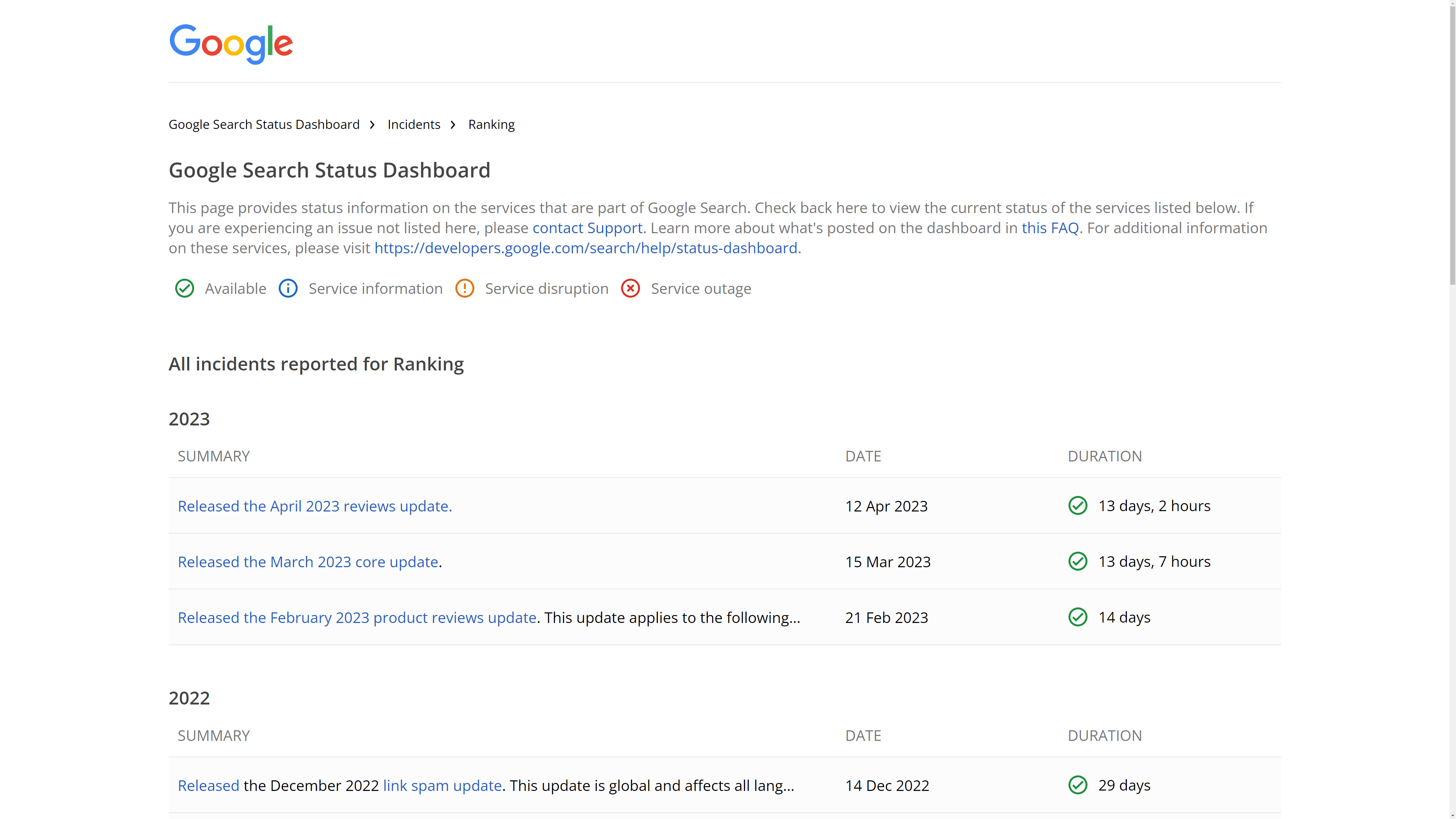
Unofficial Google Updates
Rank tracking tools recorded a lot of volatility in Google search results last month, from April 20th during the Reviews Update (see Google News April 2023) thru to the end of the month, although the update had stopped rolling out on April 25th. Volatility continued well into the month of May. You could interpret this as continued volatility from the Reviews update or as other unofficial (or phantom) updates released by Google.
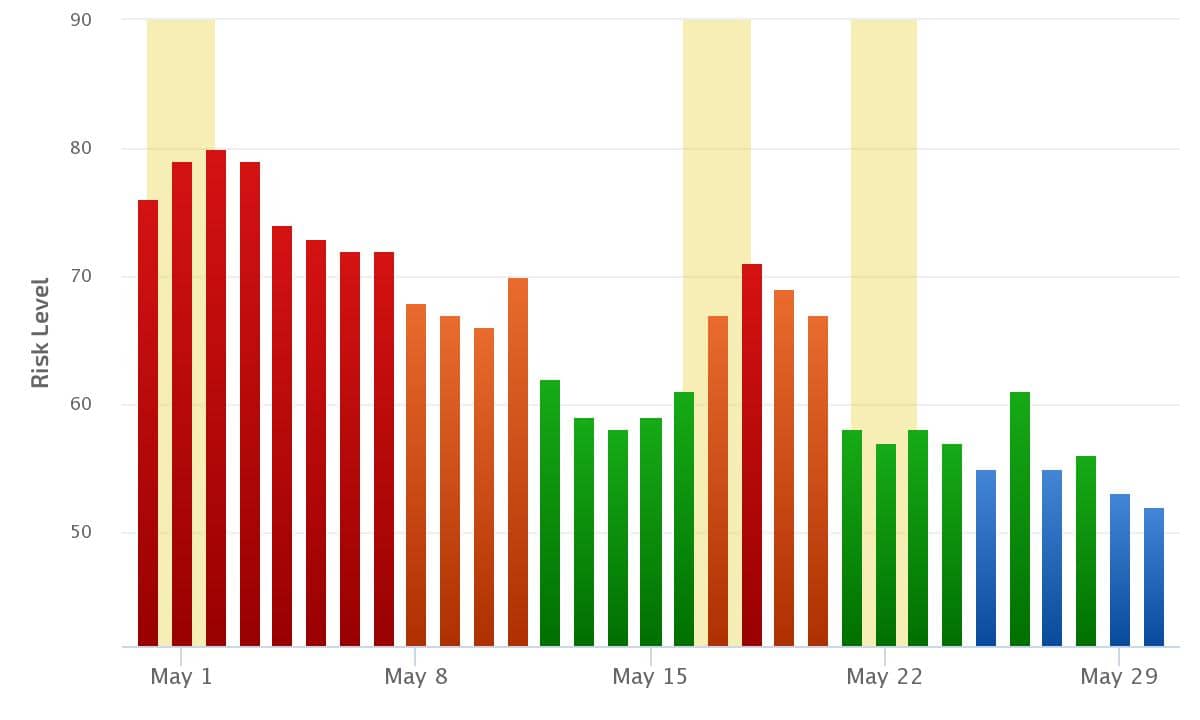 RankRanger - Google Desktop SERP Fluctuations: last 30 Days</a>" width="1200" height="720" srcset="https://www.seopress.org/wp-content/uploads/2023/05/02-rank-ranger.jpeg 1200w, https://www.seopress.org/wp-content/uploads/2023/05/02-rank-ranger-768x461.jpeg 768w" sizes="(max-width: 1200px) 100vw, 1200px" />
RankRanger - Google Desktop SERP Fluctuations: last 30 Days</a>" width="1200" height="720" srcset="https://www.seopress.org/wp-content/uploads/2023/05/02-rank-ranger.jpeg 1200w, https://www.seopress.org/wp-content/uploads/2023/05/02-rank-ranger-768x461.jpeg 768w" sizes="(max-width: 1200px) 100vw, 1200px" />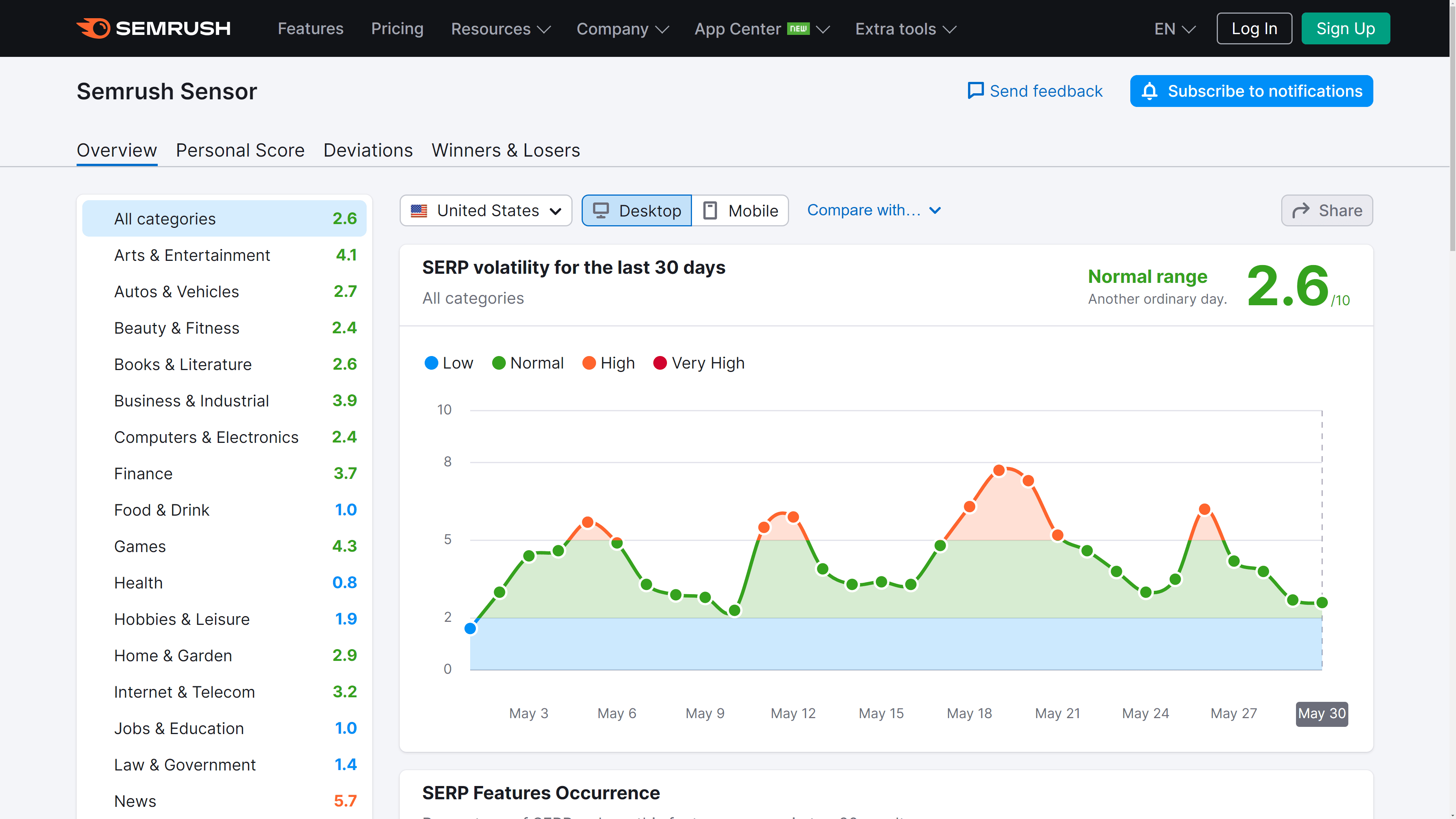 SEMRush Sensor – Desktop SERP volatility</a>" width="3840" height="2160" srcset="https://www.seopress.org/wp-content/uploads/2023/05/03-semrush.png 3840w, https://www.seopress.org/wp-content/uploads/2023/05/03-semrush-768x432.png 768w, https://www.seopress.org/wp-content/uploads/2023/05/03-semrush-1536x864.png 1536w, https://www.seopress.org/wp-content/uploads/2023/05/03-semrush-2048x1152.png 2048w" sizes="(max-width: 3840px) 100vw, 3840px" />
SEMRush Sensor – Desktop SERP volatility</a>" width="3840" height="2160" srcset="https://www.seopress.org/wp-content/uploads/2023/05/03-semrush.png 3840w, https://www.seopress.org/wp-content/uploads/2023/05/03-semrush-768x432.png 768w, https://www.seopress.org/wp-content/uploads/2023/05/03-semrush-1536x864.png 1536w, https://www.seopress.org/wp-content/uploads/2023/05/03-semrush-2048x1152.png 2048w" sizes="(max-width: 3840px) 100vw, 3840px" />Barry Schwartz, writing for Search Engine Roundtable, saw the spikes in search result changes as 4 independent unconfirmed updates and he reported on them in the following articles:
- May 1st & 2nd Google Search Ranking Algorithm Update
- Google I/O Search Algorithm Ranking Update / May 10th
- Google Search Algorithm Ranking Volatility Around May 17th
- Google Search Algorithm Ranking Volatility May 22 & 23
Barry shouts out about “unconfirmed updates” when he sees volatility in rank tracking software and chatter in SEO and webmaster forums. The examples of chatter are useful reminders that behind the red points on these graphics, websites are losing ranking, traffic and revenue. For the sake of the owners of sites losing business, it would be nice to have some more transparency from Google when big updates like these happen.
SGE – The future of Google Search
On May 10th, during Google I/O, Google demonstrated a new AI-driven search engine results page called SGE (Search Generative Experience) that may well be a sneak preview of what Google search results will look like in the not-too-distant future. You can sign up to test this version of Google in Search Labs which launched on May 25th. More details on the announcement of SGE can be found here: https://blog.google/products/search/generative-ai-search/
In the document A new way to search with generative AI (PDF), Google says that SGE is still in its early stages and that it will roll it out responsibly as they make progress on quality and safety. This said, competition from Bing (Microsoft announced that the AI-powered version of Bing was available for everyone on May 4th after 90 days of testing) probably means that there is pressure to release this new version of Google Search this summer, in English at least.
We thought it would be useful to share some screenshots from our early tests on SGE to show you what Google may look like when AI is integrated. You will quickly see that this update to the search results has the potential to cause a more important upset to ranking and traffic than any algorithm update – so we suggest that you sign up to test these new features for yourself.
Mobile hair salon in Las Vegas
This is an example of a search from our fictive case study on Debbie’s hair salon.
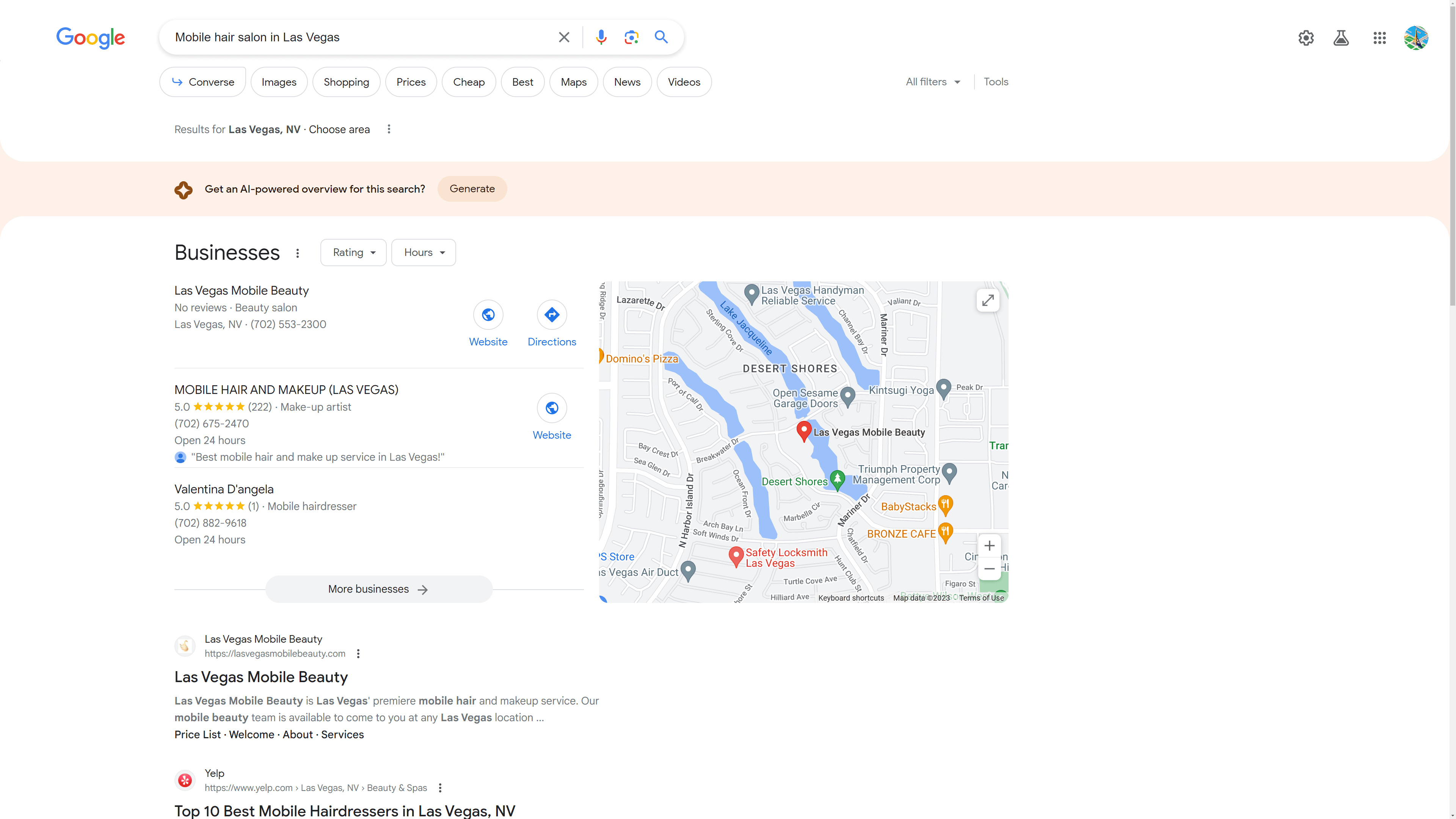
It is interesting to note that in this first example, the AI-powered reply is not automatically shown. Google may believe that it is not relevant for the searcher’s intent and that the traditional results will satisfy the user.
By clicking on the Generate button, we can get an AI-generated response.
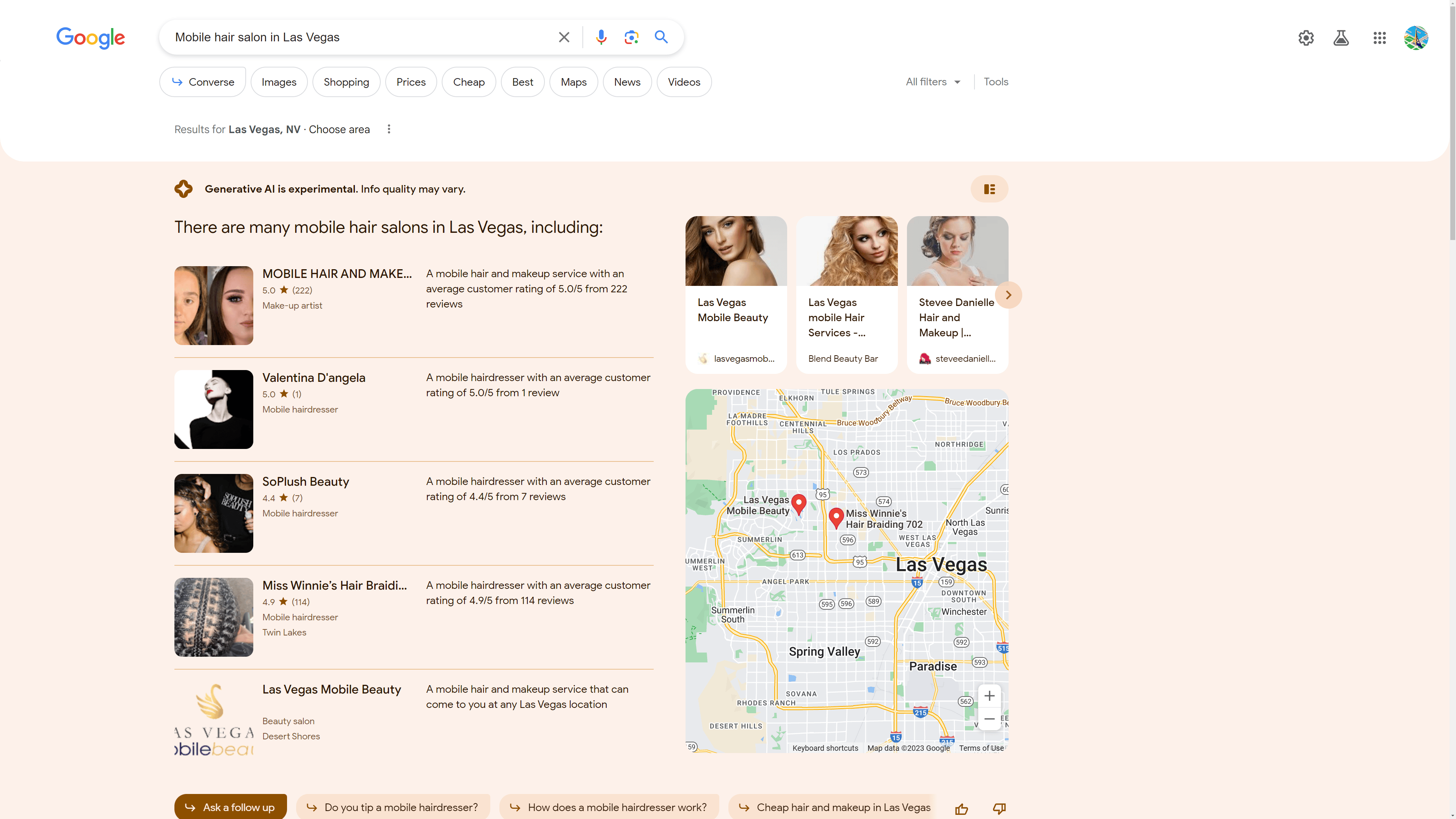
The AI-generated result features expanded local results on the left and on the top right-hand corner of the results, a carousel of links to web pages. At the bottom of the AI-generated response is an Ask a follow up button and some suggested questions. By asking another question, you can continue the conversation with the AI. As this goes on, a traditional list of results is shown below the chat, and this is updated as the conversation continues.
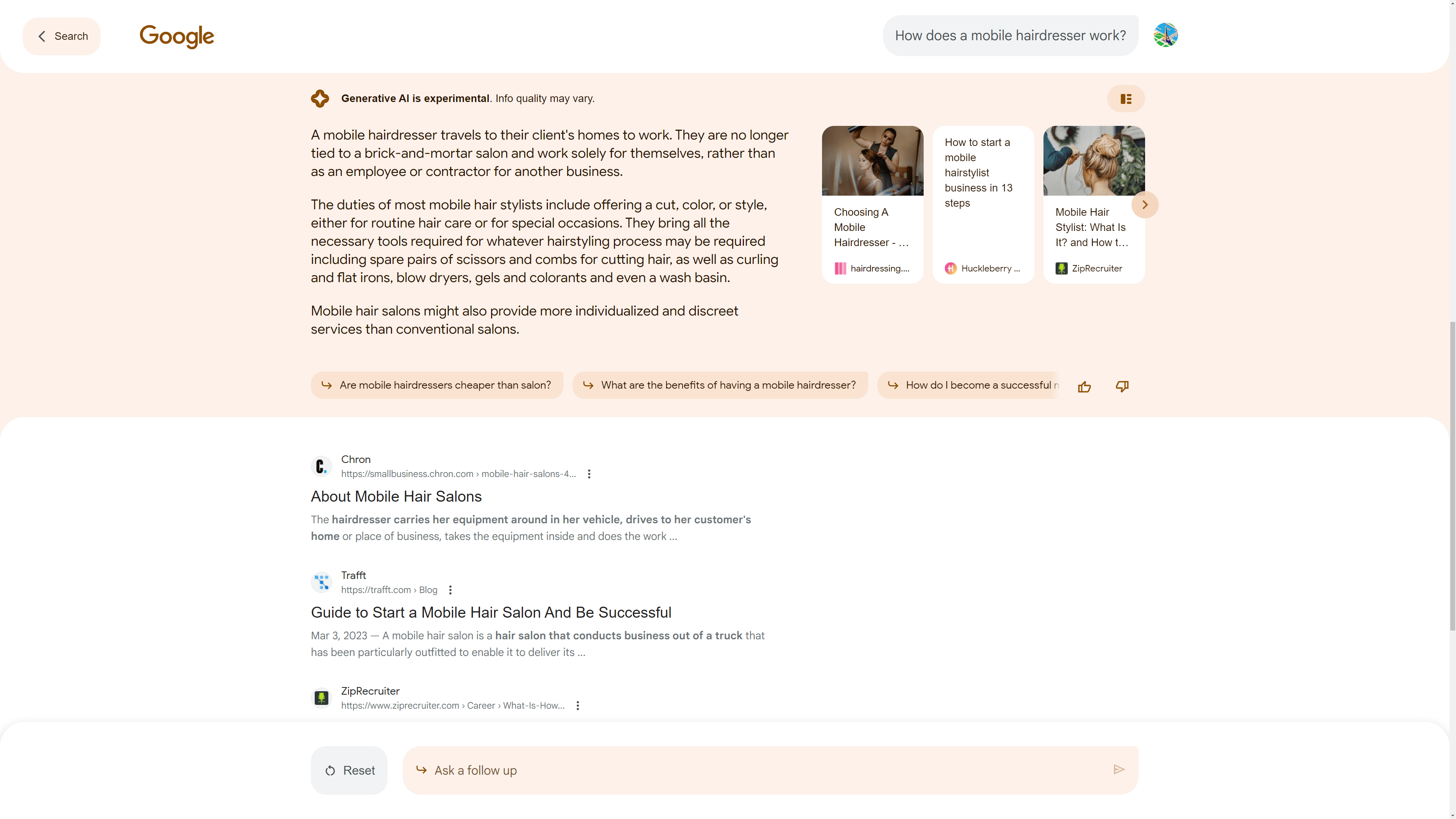
Designer sunglasses
If you have a WooCommerce site like our fictive optician Jimmy in Selling Sunglasses with WooCommerce and SEOPress, you may be interested in how shopping integrates into AI-generated replies.
In the example of the search for “Designer Sunglasses”, SGE shows some advice on choosing designer sunglasses, links to articles and a grid of product photos.

Clicking on a photo will open a pop-up showing links to online stores with prices. This data comes from Google Shopping.

How to run a 5K faster
On a more informational search like this one targeted by a site dedicated to online training programs for runners, SGE gives a list of tips as a reply to the query before letting the user discover the more traditional search results.
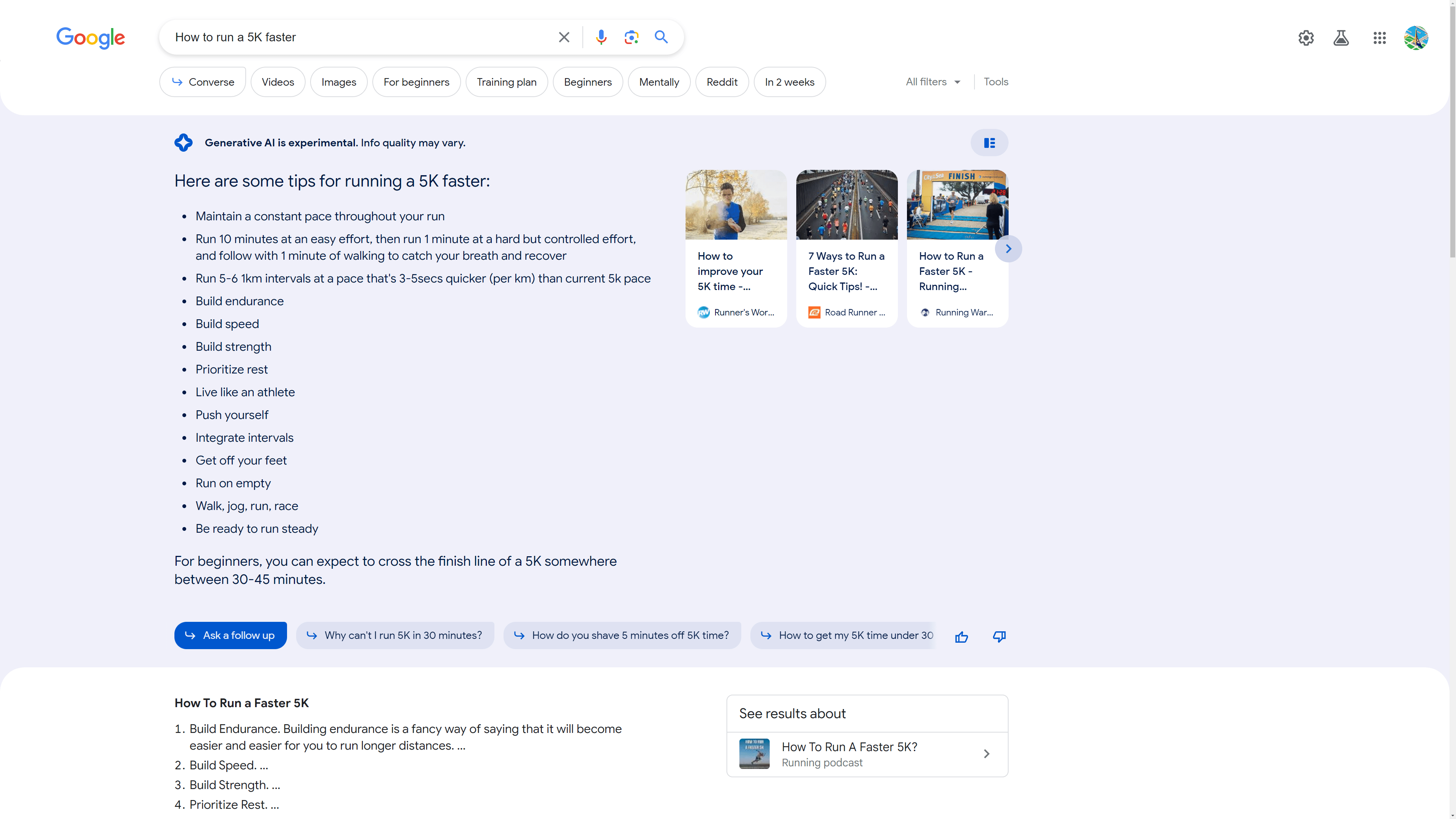
The carousel of links at the top right-hand side of the AI-generated response has links to 6 websites:
- runnersworld.com
- roadrunnersports.com
- runningwarehouse.com
- training4endurance.co.uk
- ukfitnessevents.co.uk
- marathonhandbook.com
The carousel can be expanded to show links embedded (rather clumsily) into the list of tips:
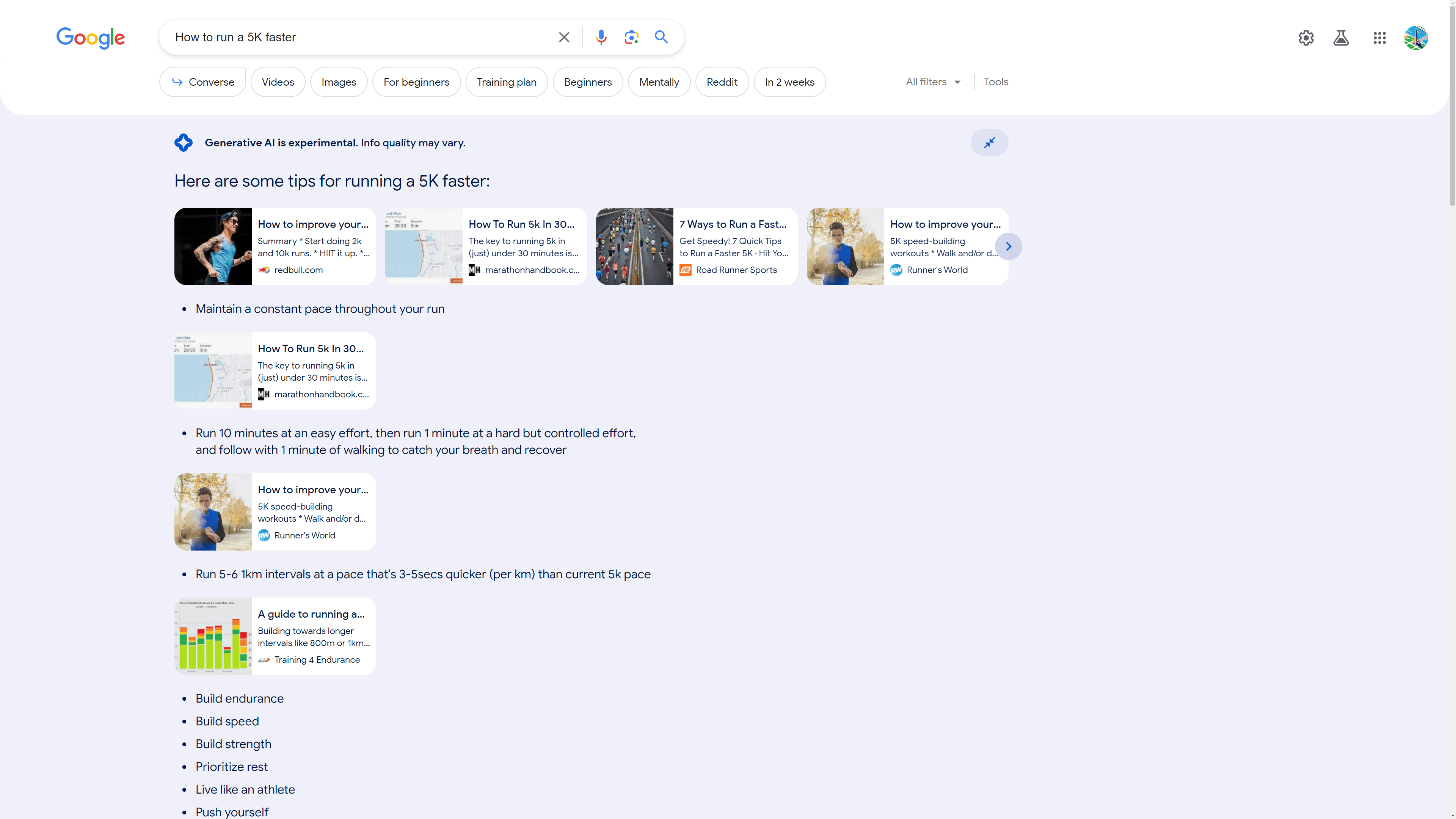
The 10 links embedded in the article go to the same 6 sites with runnersworld.com and roadrunnersports.com getting multiple links. These links are often to passages in pages rather than to the main URL. These deep links seem to be used much more in SGE than in traditional search results.
To compare, the top traditional search results, showing below the AI-generated response are:
- https://www.runningwarehouse.com/learningcenter/training/race-prep/how-to-run-a-faster-5k.html (featured snippet)
https://www.roadrunnersports.com/blog/run-a-faster-5k - https://www.runnersworld.com/uk/training/a774699/5-simple-ways-to-improve-your-5k-time/
- https://www.youtube.com/watch?v=2GWm3JMYKbA
- https://www.womensrunning.com/training/road/guide-faster-5k/
- https://training4endurance.co.uk/running/5k-training/
- https://www.runstreet.com/blog/run-fastest-5k
- https://www.t3.com/features/how-to-run-a-faster-5k
Comparing the sites featured by AI and the sites in the traditional top 10 results, we can see that the top 3 are the same three sites: runnersworld.com, roadrunnersports.com and runningwarehouse.com. Tomorrow, these sites may continue to get the same visibility from Google search, and it is an early indicator that sites that optimize for search engines today by providing excellent content, will continue to get visibility in search engines tomorrow.
Google I/O 2023 Search announcements
Google I/O is an annual developer event organized by Google that often features product announcements for Google Search and other Alphabet products like Android, Pixel, Google Workspace, Chrome, etc. As well as announcing SGE (Search Generative Experience) discussed above, Google announced some other news for search this year on May 10th:
A new About this image feature that will be launching in English in the US that will give context on images including whether it is known to have been generated by AI.
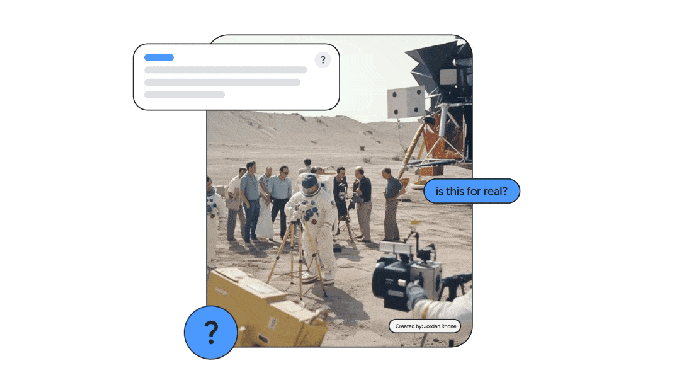
A Perspectives filter that showcases content in a new format and allows the user to filter the results by the different perspectives possible. In the example “How to make friends in a new city”, the perspectives shown are “Someone under 20”, “As a guy”, etc. Information provided in these results will make use of content called “Hidden Gems” by Google. It says that it can find hidden gems thanks to its Helpful Content system. A hidden gem could be, for example, a single great reply in an otherwise lowly-ranked forum discussion page.

Improvements to Google Bard were announced as well as news that Bard has been made available in 180 countries in US English, Japanese and Korean and will shortly include integration with other tools including Adobe Firefly, opening the option to generate images.
A new metric for Core Web Vitals. INP (Interaction to Next Paint) measures the time it takes for a page to react to a user interaction and will replace FID (First Input Delay) in Core Web Vitals in March 2024. A good user experience will be considered as a INP that is less than 200 ms. Over 500 ms is considered as “Poor”. The metric is already integrated into PageSpeed Insights.
Translated results now available in more languages
On May 23rd, Google updated its documentation on Translated Results in Google Search to indicate that this feature has been added to search results in Bengali, English, French, German, Hindi, Marathi, Portuguese and Spanish.
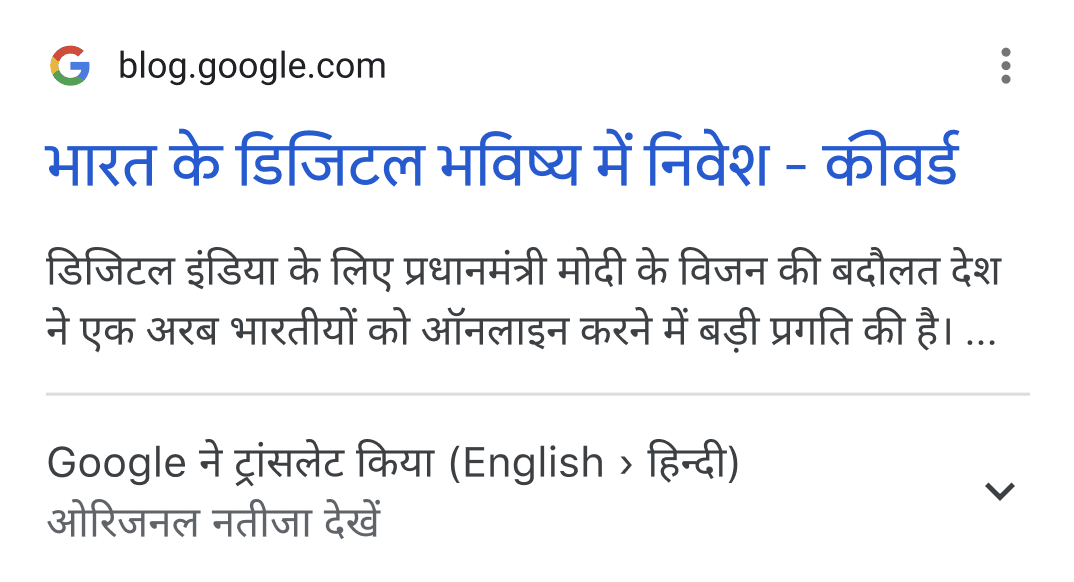
Through this feature, Google can propose links to pages that were not originally written in the user’s language. The title link and description are machine translated into the local language and clicking on the link will send users to a version of the page translated by Google Translate or by the Chrome in-browser tool.
Previously translated results were of English results to the following languages: Indonesian, Hindi, Kannada, Malayalam, Tamil, Telugu. The new documentation says it may translate results into the following languages: Bengali, English, French, German, Hindi, Indonesian, Kannada, Malayalam, Marathi, Portuguese, Spanish, Tamil, Telugu. It is not clear from which languages content will be translated.
If your site has been shown as a translated version in Google Search results, you will be able to filter Google Search Console Performance reports to show only translated results. Chose Add filter and click on Search appearance to see a list like this from which you can see the Translated results option.
